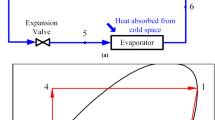Abstract
A 3D calculation model of a refrigerator-ejector was built and simulated in a compression/injection hybrid refrigeration cycle system by using the FLUENT software of CFD. The effect of thermodynamic parameters (the pressure of primary fluid and secondary fluid) on the performance of the refrigerator-ejector was studied. The boundary conditions were set according to the actual operating condition and the parameters of refrigerator experimental sample. The numerical calculation results show that there is one optimal pressure of primary fluid, i.e., p popt = 0.06612 MPa, corresponding to the maximum entrainment ratio, i.e., u = 0.568; and there is one optimal pressure of secondary fluid, i.e., p hopt = 0.04837 MPa, corresponding to the maximum entrainment ratio, i.e., u = 0.564.
Similar content being viewed by others
References
Liu Yicai, Cao Lihong, Yang Zhihui, Liu Zhenli, Huang Qian, Xin Tianlong. Study on a new-typed compression/injection hybrid refrigeration cycle for household refrigerator. Cryogenics and Superconductivity, 2008, 36(1): 42–45 (in Chinese)
Cao Lihong, Liu Yicai, Yin Zheng, Liu Zhenli, Huang Qian, Zhang Mingyan. Experiment research and analysis on compression/injection hybrid refrigeration cycle for household refrigerators. Chinese Association of Refrigeration 2007 Air-conditioning Academic Convention, Hangzhou, China, 2007, 641–645 (in Chinese)
Cao Lihong, Liu Yicai, Yang Zhihui, Liu Zhenli, Huang Qian, Yin Zheng. Study on a new kind of compression/injection hybrid refrigeration cycle. The 10th Academic Convention of Engineering Thermophysics, Chongqing, China, 2006, 446–452
Liu Yicai, Cao Lihong, Yang Zhihui, Liu Zhenli, Huang Qian. Analysis of energy saving technique of refrigerators. China Appliance Technology, 2006, (5): 42–44
Aphornratana S, Eames I W. A small capacity steam-ejector refrigerator-experimental investigation of a system using ejector with movable primary nozzle. International Journal of Refrigeration, 1997, 20(5): 352–358
Chaiwongsa P, Wongwises S. Effect of throat diameters of the ejector on the performance of the refrigeration cycle using a two-phase ejector as an expansion device. International Journal of Refrigeration, 2007, 30(4): 601–608
Xu Haitao. The theories and numerical research of steam-jet ejector. Dissertation for the Doctoral Degree. Nanjing: School of Mechanical and Power Engineering, Nanjing University of Technology, 2003, 69–85
Xu Haitao, Sang Zhifu. Thermodynamic models for calculating entrainment ratio of steam-jet ejector. Journal of Chemical Industry and Engineering, 2004, 55(5): 704–710
Liu Yicai, Cao Lihong, Yang Zhihui, Liu Zhenli, Huang Qian. Theoretical research on gas-liquid two-phase flow at outlet of refrigerator capillary. Journal of Central South University (Science and Technology), 2007, 38(3): 450–453 (in Chinese)
Liu Yicai, Cao Lihong, Yang Zhihui, Liu Zhenli, Huang Qian. Numerical modeling and experimental investigation of nonadiabatic capillary tube in the refrigerator. ICCR2008, Shanghai, 2008
Wang Quan, Xiang Xiongbiao. A study of method for calculating jet coefficient of steam jet compressor. Acta Energiae Solaris Sinica, 1997, 18(3): 314–321
Liao Guojin, Ba Dechun, Wang Xiaodong. Study on supersonic flow field in steam ejector by 3D simulation. The Academic Fig. 7 Changes of entrainment ratio under different pressure of secondary fluid Convention of Vacuum Metallurgy and Superficial Engineering, 2005, 263–266
Li Haijun, Shen Shengqiang, Zhang Bo, Li Sufen. Numerical analysis on flow parameters and performance of steam ejector. Journal of Thermal Science and Technology, 2005, 4(1): 52–57
Yang Yanqin, An Zhiqiang, Jing Shudong. Study on numerical simulation of ejector flow field. Journal of Southwest University for Nationalities Natural Science Edition, 2006, 32(2): 316–324
Rusly E, Aye L, Charters W W S, Ooi A. CFD analysis of ejector in a combined ejector cooling system. International Journal of Refrigeration, 2005, 28(7): 1092–1101
Bartosiewicz Y, Aidoun Z, Desevaux P, Mercadier Y. Numerical and experimental investigations on supersonic ejectors. International Journal of Heat and Fluid Flow, 2005, 26(1): 56–70
Author information
Authors and Affiliations
Corresponding author
Rights and permissions
About this article
Cite this article
Cao, L., Liu, Y., Wan, C. et al. Effect of thermodynamic parameters on the performance of refrigerator-ejector. Front. Energy Power Eng. China 4, 517–521 (2010). https://doi.org/10.1007/s11708-010-0004-2
Received:
Accepted:
Published:
Issue Date:
DOI: https://doi.org/10.1007/s11708-010-0004-2




